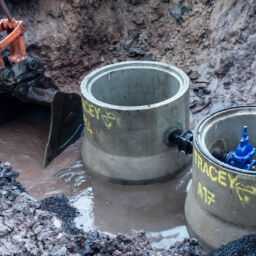Finger pointing, passing the buck, shifting responsibility… This seems to be a common theme when it comes to installing in-duct smoke detectors on new construction projects. Mechanical contractors, electrical contractors, fire contractors… Who’s responsible for making sure these detectors get installed properly? Perhaps this confusion is less about whose scope of work the detectors fall under, and more about the uncertainty contractors feel regarding the proper installation and placement of such fire protection devices. I wish I could say differently, but the answer regarding responsibility is probably not as cut and dry as we would prefer. Like many other endeavors on a construction site, the installation of in-duct smoke detectors requires a coordinated effort between all parties. The mechanical contractor is often responsible for mounting the detectors. I would expect he wouldn’t want anyone else cutting in to and attaching to his ductwork anyhow. The electrical contractor is often required to run conduit to the location of the detector and frequently required to manage the subcontract for the fire alarm company. In the end, the fire alarm contractor is responsible for making sure the device functions properly and reports to the fire alarm control panel. Coordinate effort.
NFPA 90A, Where Required
NFPA 90A is the Standard for Air Conditioning and Ventilation Systems. This code states that an in-duct smoke detector is required on the SUPPLY side of any HVAC unit greater than 2000cfm. Those detectors must be located downstream of air filters and ahead of any branch connections. If you can’t get ahead of any branch connections – you must have one provided in each branch. In addition to the supply side detector, NFPA 90A states that an in-duct smoke detector is required on the RETURN side of any unit greater than 15,000cfm. These detectors are required at each story prior to the connection to a common return and prior to any recirculation or fresh air inlet. They are not required where the entire space is protected by area smoke detection.
NFPA 72, Means of Installation
NFPA 72 is the National Fire Alarm Code, the standard for the installation of fire alarm system components. This first of all, the NFPA 72 code reminds us that in-duct smoke detectors are NOT a substitute for open area detection. NFPA defers to manufacturer’s published instructions for installation requirements. Manufacturer’s instructions advise that in-duct smoke detectors be located at a minimum of 6 duct-widths from a bend or other obstruction. This means that if you have an 18″ wide duct, the detector should be located a minimum of 9′-0″ downstream of a bend or other obstruction. This is often difficult to accomplish. The contractor needs to be aware that the 6 duct-width guideline is based on the fact that airflow is disrupted as it comes around a bend. The duct detector requires the conditioned air to flow through a 1/2″ diameter sample tube that protrudes into the ductwork. If the airflow is bouncing all over the ductwork, it is less likely to make it into the sample tube as required for proper smoke detection. Because the code states “should” instead of “shall” be located a minimum of 6-duct widths, it is the responsibility of the contractor to use his own best judgment in locating the detector as far away from a bend as possible. Since HVAC ducting is often located above the finished ceiling or high up in the rafters out of visible range, the location of in-duct smoke detectors must be permanently and clearly identified and recorded. Fire officials and service personnel must be able to identify the location of these detectors. Where in-duct smoke detectors are installed more than 10′-0″ A.F.F. or where the detector is not visible to responding personnel, remote indicators must be provided to locate the device with ease. On occasion, where it is acceptable to the AHJ, remote indicators may be eliminated if the detector is specifically identified and clearly annunciated at the FACP and annunciators.
Alarm/ Supervisory & Fire Alarm Shut Down
Once the in-duct smoke detectors have been sufficiently installed, there seems to be an ongoing debate as to whether the detectors should annunciate a supervisory signal, requiring investigation to determine if there is a fire, or if the detectors should annunciate an alarm signal, immediately evacuating the building and calling the fire department to the site in response. Proponents of the supervisory signal argue that in-duct smoke detectors are a common source of false alarm signals. Often when heaters are first started up at the start of winter, the heat blowing through the ductwork burns off the dust (we all know the smell of the heater being run for the first time) thus causing an alarm. Neither owners, nor fire officials want to evacuate the building or run trucks to a site that proves to be a false alarm. On the other side of the argument, however, is the concern that if the detector activates and then it is doing its job and an alarm signal is required to ensure the safety of the occupants. No risk allowed. Because there are valid points on both sides of the discussion NFPA 72 has opted to take the middle ground and allow this to be a local decision. The Fire Alarm Code states that in-duct smoke detectors can be EITHER Alarm-Initiating OR Supervisory-Initiating. The local AHJ will most likely have a preference. The only definitive action the code endorses, per NFPA 90A, is that in-duct smoke detectors must automatically stop their respective fans; and that any time a duct detector is provided, it shall be connected back to the building FACP.
Duct Detectors & Clean Agents
One other question that often comes up in relation to fire systems is how duct detectors play in to clean agent suppression systems. Clean agent systems have their own control panel and require a means of fire detection prior to discharging a fire suppressing agent. The question arises when a duct detector is provided on the CRAC unit installed within a computer room that is protected by a clean agent system. Who monitors the status of the in-duct smoke detector and does it’s alarm activation play in to the clean agent distribution sequence? Let me answer the first question by explaining a bit about the second question… NFPA 2001 is the Standard for Clean Agent Suppression Systems. This standard requires that forced air ventilation systems be shut down ONLY where their continued operation would adversely affect the performance of the fire extinguishing system. Furthermore, the standard states that completely self-contained recirculating ventilation systems (i.e. Liebert or CRAC units) shall be not required to be shut down. This is because the recirculation of air within the protected space does NOT adversely affect the performance of the extinguishing system; in fact, it assists in the retention time the agent is held in the atmosphere. The continued recirculation of air within the protected space actually helps to extinguish the fire and prevent re-ignition. That said, the in-duct smoke detectors play no role in the clean agent distribution sequence. Since the in-duct smoke detector is not a part of the clean agent distribution sequence, it is not tied to the clean agent fire panel. The detector must now be tied to the base building fire alarm control panel. Whether or not the activation of the detector will cause the unit to shut down is now an optional owner decision, although in this case, it is not recommended.
To wrap it up, I would like to thank you all for taking the time to learn a little more about this often confusing point of construction coordination. The more educated all associated contractors are, the more likely we are to install a fully functioning fire alarm system regardless of whose scope it falls under.
BY by GAHZLY
El Sewedy wire prices 2022
#Duct #Detectors #Construction #Coordination


